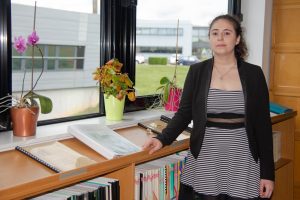
Can you remind us of the context in which your mission took place?
Since 2015, the LMA laboratory and the University Hospital of Poitiers have been working together on the processing of data from medical imaging within the team DACTIM-MIS (Data Analysis and Computations Through Imaging Modeling-Mathématiques, Imagerie, Santé). I have been working in this team since 2016 and my research has focused on energetic substrates kinetics and on tumour growth.
On their side, since 2015, research teams of the University of Pavia have been conducting studies on tumour growth. They have opted for a model describing tumour mechanical impact and growth
With various past and present collaborations, the joint work of these teams has already proved successful. In the present case, the union of the two visions of the tumour behaviour (mechanical impact for the Italian team and energetic exchanges for our team) could lead to the elaboration and study of an innovative, relevant and promising model for the description and prediction of tumour growth.
How did your mission unfold?
First, I gave a presentation to the department of Architecture and Civil Engineering of the Pavia University. It enabled me to meet other researchers. They may be interested in a future collaboration on anatomical structures modelling.
I then attended a two-day workshop on “Recent advances in Phase-Field modeling: from Engineering to Biology” where I was able to interact with different teams, from Pavia and also from other countries. My participation helped me to better understand the possibilities arising from their approaches based on phase field models for solving interfacial problems.
Have any collaboration projects come to fruition from this mission?
With the mathematics department of the Pavia university, of course! We have established models describing both mechanical and nutritic tumour behaviour. Now we will study them and compare them to real data.
We will soon have a 7 Tesla MRI in Poitiers that will enable us to get more precise data of the metabolites of interest. This way, we will be able to make substantial progress in our shared research. And we don’t intend to stop there!
Regarding the department of Architecture and Civil Engineering, both teams seem very motivated to work together, so all doors are wide open.
Any anecdote to tell us?
To go to Pavia by train, I had to catch a connection in Zurich, where apparently speaking French, Italian and English (that is, two out of the three official languages of Switzerland and the chief international language) is not enough to be guided. Everybody was answering me in German and was expecting me to make an effort…Thankfully, I managed to catch my train!
Anyway, let’s talk pizza! I’ve learned that the tomato sauce is not a requisite, and that it can be easily replaced by fresh tomatoes.
What can be, according to you, the benefits of the EC2U project?
A lot of people see Europe as a faraway concept that brings them no benefits. EC2U puts Europe within reach for citizens of medium sized cities. On the Research side, it enables to strengthen the links that are already present between the partners of the Alliance. Moreover, the cultural impact for all the participants is far from negligible.
